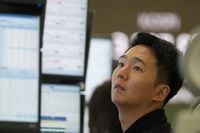Wall Street wrapped up August 2025 with a mix of celebration and caution, as stocks retreated from fresh record highs on Friday, August 29, despite a string of winning months for major indexes. The S&P 500, Dow Jones Industrial Average, and Nasdaq Composite all closed in the red, snapping a streak of daily gains but still managing to secure impressive monthly advances, according to The Associated Press and other major outlets.
The S&P 500 fell 0.6% on Friday, just a day after notching an all-time high. The Dow slipped by 0.2%, and the tech-heavy Nasdaq Composite dropped 1.2%. For the month, however, the S&P 500 ended up 1.9%, its fourth consecutive month of gains, and is now up 9.8% for the year. The Dow posted a 2% monthly gain, and the Nasdaq capped August with a 1.6% rise, marking its fifth straight winning month—the longest such streak in nearly a year and a half, as reported by Yahoo Finance.
So, what was behind Friday's pullback after such a strong run? Sam Stovall, chief investment strategist at CFRA, offered a simple explanation: "The reason the market is down today is primarily because we are heading into a long weekend, and a lot of traders don’t like to have a hefty exposure over a long weekend because of the news that could come out and take them by surprise." But, as always, there’s more to the story. Mixed economic data and a sense that stocks had run up too far, too fast, gave investors an excuse to lock in profits and reassess the landscape.
One key factor weighing on sentiment was the latest inflation reading. The Commerce Department reported that prices, as measured by the personal consumption expenditures (PCE) index, rose 2.6% in July compared with a year ago. This matched economist expectations and was unchanged from June. However, the so-called "core" PCE index—which strips out volatile food and energy costs—rose 2.9% from a year earlier, up from 2.8% in June, marking the highest annual pace since February, according to AP. This is still well below the roughly 7% peak seen three years ago, but it remains above the Federal Reserve’s 2% target.
Inflation wasn’t the only concern. U.S. consumer sentiment took a notable hit in August. The University of Michigan’s closely watched survey showed that Americans’ confidence in the economy slipped to its lowest level since May, reflecting growing worries about both inflation and the broader economic outlook. As Yahoo Finance reported, this marked a three-month low for consumer sentiment, with many respondents expecting inflation to surge over the next year.
Against this backdrop, technology stocks led Friday’s declines, offsetting gains in sectors like health care. Dell Technologies suffered the biggest drop among S&P 500 stocks, sliding 8.9% after reporting second-quarter revenue that beat analysts’ estimates but warning of margin pressures and weak PC sales. Other tech giants followed suit: Nvidia fell 3.3%, Broadcom dropped 3.6%, and Oracle slid 5.9%. Even Nvidia, fresh off a much-anticipated earnings report, couldn’t escape the selloff, ending the week down over 3%.
Not all companies fared poorly, though. Petco Health & Wellness and Autodesk bucked the broader market trend, jumping 23.5% and 9.1%, respectively, after posting better-than-expected quarterly results. Meanwhile, Ulta Beauty tumbled 7.1% despite beating Wall Street’s earnings and revenue forecasts, and Marvell Technology sank 18.6% after issuing guidance that fell short of expectations.
Despite Friday’s dip, the broader market narrative remained positive. August’s gains extended the S&P 500 and Dow’s winning streaks to four months—the longest since September 2024—while the Nasdaq’s five-month climb was its best since early 2024. The Russell 2000, which tracks small-cap stocks, eyed a 6% jump for August, marking its fourth consecutive month of gains, the longest streak in over four years, according to Yahoo Finance.
Looking ahead, all eyes are on the Federal Reserve’s next move. Federal Reserve Chair Jerome Powell signaled last week that a rate cut could be on the table at the central bank’s September meeting, especially amid signs of a slowing job market. Recent government data suggests hiring has cooled sharply since the spring, adding another layer of uncertainty for policymakers. As Ellen Zentner, chief economic strategist for Morgan Stanley Wealth Management, put it: "Today’s in-line PCE Price Index will keep the focus on the jobs market. For now, the odds still favor a September cut."
Traders seem to agree. According to CME Group data, there’s roughly an 87% chance the Fed will cut its benchmark interest rate by a quarter-point next month. Lower rates could help boost investment and make borrowing cheaper for households and businesses, but they also risk stoking inflation if price pressures remain persistent.
Chris Zaccarelli, chief investment officer for Northlight Asset Management, told AP that unless upcoming inflation reports—the producer price index and consumer price index—show a dramatic spike, the Fed is "almost guaranteed" to cut rates at its next meeting. That’s a bold call, but one echoed by many on Wall Street, given the recent economic data and the central bank’s stated goals.
The bond market reflected some of this uncertainty. The yield on the 10-year Treasury rose to 4.23% from 4.21% on Wednesday, while the two-year Treasury yield, which more closely tracks expectations for Fed action, slipped to 3.62% from 3.63%.
Meanwhile, political drama added another wrinkle. President Trump’s ongoing effort to oust Federal Reserve Governor Lisa Cook took a fresh turn on Friday, with a judge expected to rule on Cook’s bid for a temporary restraining order. While this legal battle hasn’t rattled markets yet, it’s one more variable that investors are watching as the September Fed meeting approaches.
Overseas, European markets finished mostly lower, while Asian markets closed mixed, reflecting the global uncertainty swirling around inflation, interest rates, and economic growth. Back home, U.S. markets will be closed on Monday for the Labor Day holiday, giving traders a brief respite—and perhaps a chance to catch their breath after a whirlwind month.
As the calendar flips to September, investors are left to ponder whether the market’s winning streak can continue in the face of persistent inflation, shaky consumer sentiment, and the ever-present specter of Fed policy decisions. One thing’s for sure: the next few weeks promise no shortage of intrigue on Wall Street.

